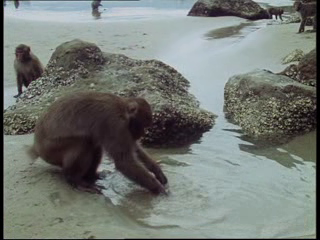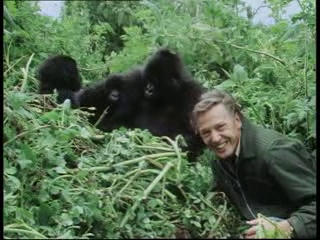Original air date: 3 April 1979
As the image below shows the episode is actually split in three parts.


The episode starts with the ‘early’ primates and after the monkey part ends with our closest relatives, the great apes.
Selected material:
Adaptability among macaque monkeys in Japan using hot springs (27’35) and other learning abilities (28’55-31′). Watching the monkeys while Attenborough tells stories of them is enough to warrant the sequence a special mention. They were developing a special culture among themselves.

The sequence of gibbons swinging about in the trees (34’40-35’50).

Unusually Attenborough mentioned the incredible fact that a third of all gibbon bones examined have shown fractures (35’40) which they survived, presumably by being vegetarians, without help carnivores would not.*
The sequence with Attenborough joining the mountain gorilla group is a special one (38′-43’40). Some people disliked it, being too anthropomorphic. Since this is probably the most spoken about sequence there is nothing to add to it. Sadly the sequence in the episode is all that was filmed. Nothing more exists!

Digging deeper
Surviving broken bones might indicate a social system that helps the injured while they are recovering. Strangely the book mentions similar statistic for the orangutan but does not mention the gibbon. The new version of the book concurs. Going beyond his works this turns out to apply to both of them. It also applies to other arboreal primates (Bulstrode [1988]). It may happen to the terrestrial chimpanzees and gorillas but that has probably other reasons. These fractures however are not as common as those mentioned in his works.
Final words: “Chimps are rather conservative cousins, removed by about 15 million years. Nonetheless, we both share many characteristics in bodies and behaviour, a common inheritance from the ancient creatures that once spent all their lives in the trees.“
References:*
David Attenborough. Life on Earth (Collins 1979, old version) p.285
David Attenborough. Life on Earth (revised edition, 2018) p.302
Bulstrode, Christopher (1988). What happens to wild animals with broken bones [The Iowa OrthopaedicJournal, Vol.10]. p.19-23.
Filming locations:
Attenborough showing a lemur in a tree in Madagascar (2′)
Showing the loris in Malaysia (12′)
Looking at monkeys in Africa (22’40)
Macaque monkeys on the island of Koshima, Japan (29′)
The most famous sequence of all, the mountain gorillas of Central Africa, on the border of Rwanda and Zaire (36′-44′)
Examples of other filming locations (without Attenborough):
Howlers and other monkeys in South America (17′)
Macaque monkeys in Gibraltar (26′)